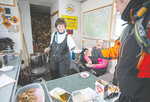Clear, 46° F
Gassed, volunteer members of the Park County Search and Rescue took a short breather from their on-snow training. They had just raced to dig a hole through more than 4 feet of snow in a simulated …
This item is available in full to subscribers.
The Powell Tribune has expanded its online content. To continue reading, you will need to either log in to your subscriber account, or purchase a subscription.
If you are a current print subscriber, you can set up a free web account by clicking here.
If you already have a web account, but need to reset it, you can do so by clicking here.
If you would like to purchase a subscription click here.
Please log in to continue |
|





Gassed, volunteer members of the Park County Search and Rescue took a short breather from their on-snow training. They had just raced to dig a hole through more than 4 feet of snow in a simulated avalanche rescue.
It’s hard work simply walking through the snow. Early in the year, it seems bottomless. But even when becoming packed under its own weight, it’s not a walk in the park at close to 10,000 feet elevation. Digging here is brutal, but much easier than working through compacted avalanche debris.
The seven-man crew, along with dozens of other volunteers, had come to the High Lakes wilderness at the top of the Beartooth Pass on Saturday to learn how to better identify areas likely to have an avalanche — and to find and rescue victims caught when a day of fun in the snow turns tragic. The two-day class was organized by the Cody Country Snowmobile Club, offered free to the general public.
In reality, search and rescue volunteers won’t be doing the digging in the event of an avalanche. It would take more time for the squad to arrive on scene than an avalanche victim has to live once buried, said Park County Sheriff Scott Steward.
“What we do mostly here is medivacing out injured people. Because up here in this kind of terrain, by the time we get here it’s just a recovery,” Steward said. “Even if we were at the trailhead, we can’t make it to the scene that fast.”
If you’re trapped under the snow, you only have a few minutes before succumbing. Avalanche rescues therefore fall on those choosing to recreate in the mountains on skis, during hikes and on motorized sleds and their friends.
“If you don’t take these classes, you’re going to be behind and you may lose somebody because you weren’t able to perform,” said Bert Miller, president of the Cody snowmobile club.
Having every member of your group prepared could mean the difference of dying on the hillside and going home to see your family. About 75 percent of those who perish in an avalanche die of asphyxiation. It usually happens within 15 minutes, said Matt Schebaum, an avalanche educator with the Mountain Riding Lab. That’s a small window of time in terrain where every step is a struggle.
“After 15 minutes, your chances of surviving go way, way down,” Schebaum said. “Having all the gear, practicing it and getting good with it really increases your chance of digging your friend out.”
Fortunately, the Friday-Saturday class was packed. During the classroom portion on Friday, organizers had to bring in additional tables and chairs to accommodate the large crowd at the Cody Holiday Inn. The second day, groups were divided into four smaller groups to ensure everyone could follow along with the lessons on using beacons, probes and shovels.
“These folks are passionate about this,” Steward said. “I’ve never been up here when, if you needed help, they wouldn’t jump in immediately to help. They all know at any given time it could be their friend. Whenever we ask, they jump in. They’re great.”
Snowmobiling is growing more popular as both local residents and visitors increasingly come to the area’s mountains — some of the best in the country for fun in the snow.
Avalanche fatalities have also been increasing, according to the U.S. National Library of Medicine. “Recently snowmobilers constitute the majority of the victims.”
In the last four decades, a total of 440 victims were killed in 324 avalanches, of which 87.7 percent were fully buried. This winter, eight people have already died in avalanches; 25 were killed in the winter of 2018-19. Some may have been avoided, said Bill Radecky of Six Points Avalanche Education.
“The moment we leave the trailhead, we need to be thinking avalanches,” Radecky said.
Safety training has been found to help reduce deaths, the National Library of Medicine found.
While education is becoming a priority locally, many from out of state aren’t ready to deal with the dangers.
“Folks coming from flat areas come out here and they’re not prepared,” Miller said.
Some of the most popular local areas are also some of the most dangerous. While Miller said the High Lakes region is relatively safe, the Cooke City area is one of the most dangerous places in the world due to the snow-load and wind. “You have to be prepared,” he said.
The price of safety equipment is close to $2,000, Schebaum said. Transceiver beacons — essential to anyone traveling in the back country during winter — cost between $300 and $500. Avalanche airbags costs between $500 and $1,200. Even probes, used to find victims under the snow, and shovels can cost $80 each. Yet, compared to the cost of a snowmobile and a truck to tote it, the cost of being safe is relatively cheap. Organizing training events is also expensive. The Cody Country Snowmobiling Club offers the training every other year with the help of sponsors and Wyoming State Trails program.
“It’s important for the club to put these on for those who want to play in the snow,” Miller said. “Safety is what it’s all about and technology is getting more and more advanced.”